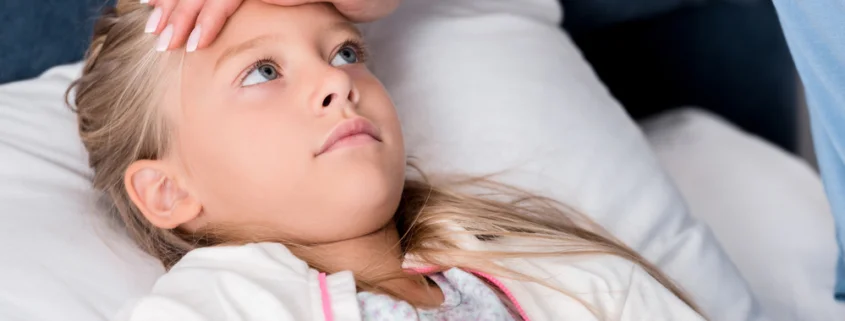Common Illnesses that Affect School-Age Children
When children attend public or private schools we are never certain what types of things they will carry home with them. Especially as the months get colder and the flu and viruses start getting passed around it is important for parents to understand some of the most contagious illnesses that are common among school-age kids so they can watch out for symptoms.
Pink Eye, or Conjunctivitis – Inflammation of the conjunctiva, a thin clear tissue that outlines the eye and eyelid.
Pinkeye is something most people will experience multiple times in their life. If your child wakes up with a yellow, crusty discharge gluing their eye shut this is a clear indication that they have contracted conjunctivitis. This highly contagious illness is spread through children getting their hands contaminated with the germ and then rubbing their eyes. It is advisable to seek prescription eye drops to ensure that the infection is cleared up. In most circumstances, it will be resolved within a few days and no permanent damage will be done. Washing hands is also very important in trying not to pass on the illness to others.
Hand-Foot-and-Mouth Disease – A virus that results in open sores inside the throat and tonsils, rashes or blisters on the body, initially showing up on the hands and feet.
A very contagious disease, hand-foot-and-mouth is first brought on by a fever and a rash that shows up initially on the hands and feet. As the disease progresses the rash can develop all throughout the body. Another symptom is painful sores and blisters in the mouth, throat, and tongue that make it difficult for the child to eat. Although this disease is not life-threatening it is very uncomfortable and can last for several days. It is so contagious that everything children touch at schools or public areas has the possibility of being contaminated. To best ward off HFMD talk to your children about washing their hands thoroughly with hot soap and water often. Hopefully, as children do this and as surfaces are disinfected thoroughly the spreading will not be so severe.
Strep-Throat – A bacterial infection called group A streptococcus that causes a severe sore throat and swollen lymph nodes.
Strep throat is another common illness that affects over 3 million school-age children every year. This type of a sore throat can be worse than other types of common sore throats and is usually identified by its ability to cause swelling in the neck lymph nodes. It is only diagnosed through a lab test done through your doctor’s office. Strep does require a prescription antibiotic to effectively clear up the illness which can last several days. This infection also comes with a fever, sore throat, loss of appetite, and upset stomach. If you are unsure whether your child’s sore throat is strep throat or something milder, it is best to get a swab lab test done to be sure.
Head Lice – A human parasite that survives from the blood and warmth of a human host.
Head lice are indeed a common illness among school-age children. This is partly due to the fact that young children, especially in schools, are in direct contact with other children throughout the day. Head lice are also spread through the sharing of hats, coats, hair accessories and many other items that can be carrying head lice or eggs. Adult lice are the size of a sesame seed and light brown in color. They crawl from hair strand to hair strand laying nits on the individual strands with a glue-like secretion that makes the eggs difficult to peel off. The eggs will be a big indication that your child has head lice. Major symptoms include itching, red swelling spots, adult nits on the scalp, and difficulty sleeping at night when the head lice are active. Be sure to remember that symptoms can take up to three weeks to manifest. A good way to ensure your child does not become infected is to do regular head lice checks.










